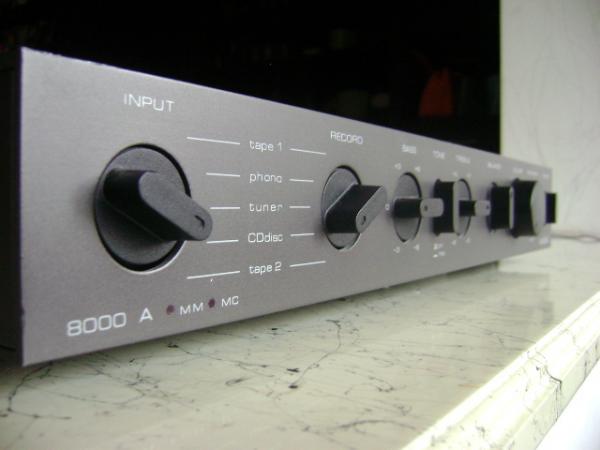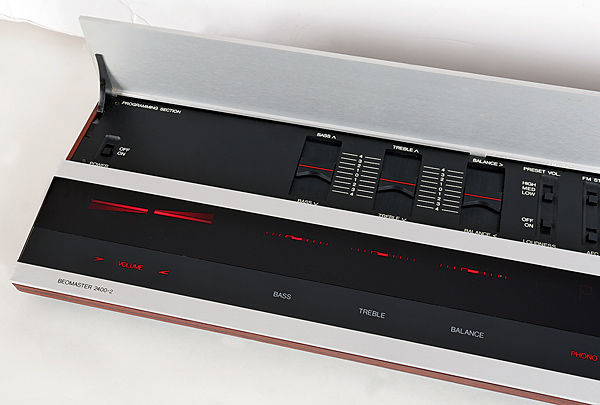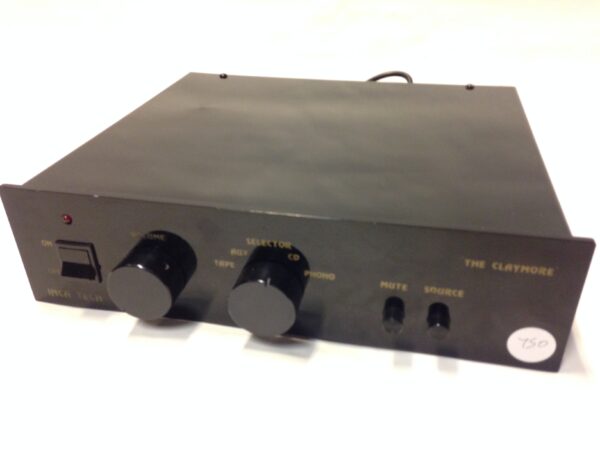Nytech’s iconic ‘Calculator Tuner Amplifier’ is virtually forgotten these days, although it made a big impact on the British hi-fi market when it was hot in the late 1970s. When it was first released in 1972, calculators were practically the width and depth of an LP record, and they, like the Nytech, were connected into the mains supply. Let us not forget that this was a time when the world was still migrating from tube to solid-state, and electronics were not quite as small as they are now. The top panel was crammed with buttons, almost like the supersized electric adding machines of the day, but instead of a numeric display, there were three tidy panel meters for the radio tuner.
The CTA 252 was the first product to come out of Nytech’s new factory in Chew Magna, just outside of Bristol. Its creator, Richard Hay, was a smart young twenty-eight-year-old who’d worked alongside Arthur Radford and Arthur Bailey after graduating with an electronics degree from Southampton University in 1967. Hay had always enjoyed music, but his first love was aerospace, and he had hoped to work for Hawker in the future, building fast aircraft like his childhood hero, Barnes Wallis.
Radford Electronics provided a good foundation for Hay, as a professional engineering firm that created and constructed its own test equipment, allowing Richard to apply his knowledge to real-world products. He grew up in Bangalore with his family, where he developed an interest in hi-fi after receiving Heathkits from the mother country. He had a launch pad for his creativity at Radfords; one of his innovations, the Edinburgh Wireless Tuner, was published in Wireless World, an industry-wide publication of electronics design excellence at the time.
As chief engineer, he began working with Arthur Radford toward the conclusion of his tenure there, with the goal of moving the business away from its fine but ageing variety of tube amplifiers and toward new-fangled transistors. His passion for valve amplifiers influenced his solid-state designs. Nytech products were essentially “valve designs but performed using solid-state devices, with capacitor-coupled outputs rather than transformer-coupled outputs,” according to his son Robert.
Engineers Dave Alner and Paul Hamblin left Radford in 1972 to form Nytronics Ltd. with Richard Hay. They collaborated on the new CTA 252, which was designed as a custom console for a music center chassis. The requirement to fit into a pre-existing cabinet beside a Dual turntable resulted in the distinctive plastic top surface. It was given the name ‘CTA’ because of the way it was built, which was influenced by an early Canon desktop calculator.
It was a superb piece of art, with a lot of Richard Hay’s Radford DNA on display. With a modest 25W RMS per channel into a 4 ohm load, it still drove speakers admirably and, as former Nytech test engineer Phil Balaam put it, “had a very unique sound.” Part of the reason for this was the AC-coupled power amplifier architecture, which made it a very safe amplifier in terms of loudspeaker (not blowing up) safety. Balaam explains, “It had a capacitor in the signal route, which was frowned upon by many on sonic grounds, but he invented some very smart solutions that got around it.”
Another fascinating aspect of the design was the physical architecture, which consisted of many plug-in printed circuit boards that eliminated the need for yards of interior wiring (common in amplifiers of the time). The disc input stage was likewise plug-in, allowing MM or MC to be easily accommodated, and the 252 included a sophisticated FM tuner head that later appeared in the A&R Cambridge (now Arcam) T21 tuner.
The CTA 252 has a long list of features, including a built-in tuner and phono input, as well as slider controls for bass, midrange, and treble, balance, and loudness. A mono switch, a tape monitor, and speaker switching for two pairs of speakers were all present. Because there were so few FM stations on the air at the time, the tuner came with AFC and four presets, which was more than enough. Two headphone jacks completed the picture, indicating the unit’s origins as a ‘deluxe music center’…
In 1975, the Nytech was released for the princely sum of £93. Inflation plagued Britain at the time, and the price grew quickly; by 1978, it was nearly twice as expensive – but that didn’t stop the hi-fi journalists from praising it. Indeed, the Nytech’s receiver status was sometimes overlooked, and it was frequently touted as an outstanding sounding amplifier in its own right. If you can’t afford a Naim preamp/power amplifier combo, magazines like Popular Hi-Fi urged you to buy it.
Electronically, the CTA had a reasonably simple design that adhered to solid engineering principles. With a few adjustments to the amp and power supply, we were able to get extremely good performance out of something that was considerably more than the sum of its parts. The Nytechs all used the same basic Class AB push-pull amplifier, which was powered by a single supply rail and had the speaker AC-coupled to the output. According to Phil Balaam, clever detail design work allowed the circuit to go down to roughly 15Hz with less than 1dB of insertion loss. The amp sounds good even by today’s standards, with a bubbly, rhythmic tone and strong stereo sound-staging.
Nytechs, like the NAD 3020, were never too strong, yet they nonetheless thoroughly defied their low power ratings. Instead of a soft and meek solid-state sound, they produced a huge, bold one. Nytechs were always pleasant to listen to and sang with most sorts of music, but they lacked ‘hear through’ transparency and tone light and shade. The tuner is insensitive in comparison to modern radios, but with a good aerial, it produces a stunningly rich and warm sound that rivals practically everything on the market today.
Nytech began refining the design after realizing that audiophiles, not music center users, were the company’s prospective customers. In 1977, a new version was released with some component revisions, followed by the addition of a direct, non-switched speaker connection and an enhanced phono stage. The CTA 252 XDII followed in early 1978, with an upgraded toroidal transformer that offered the unit 25W RMS into 8 ohms instead of 4. Later in 1979, the XDII had a little redesign with better switchgear, 6.3mm binding posts for the DIN speaker terminals, and a greater voltage for the ‘link’ connector around the rear in anticipation of Nytech products.
Along with Linn, Meridian, and Naim, Richard Hay was a member of the Active Loudspeaker Standards Organization. It was a working group formed to establish standards for active speakers in order to ensure brand interoperability. Because of Hay’s enthusiasm for these technologies, it wasn’t long before the Nytech receiver began to disintegrate into component components, ready to be activated…
The CPA 602 power amplifier was first introduced as a power upgrade for the CTA 252; it produced well over 60W RMS per channel and had a sound that “rivalled Naim,” according to Balaam. This was followed by the CTP 102 tuner/preamplifier, which was essentially the CTA 252 sans the power amplifiers, in 1979. The EXO 102/3 electronic crossover and CXA252 crossover amplifiers were introduced in early 1980.
Owners of CTA 252s with ARC or Linn speakers could add the CXA252 to turn their system into a full active loudspeaker, with the CXA’s power amps producing HF and LF for the left channel and the CTA 252’s power amps doing the same for the right channel. “The increase in musical quality was remarkable,” Balaam asserts emphatically, “and Nytech/ARC active systems became the best value for money upgrade available, making Nytech/ARC active systems highly sought.”
They were quite popular, with many consumers reportedly foregoing Naim active systems in favor of Nytech’s new high-end components. “The CPA 602 power amp is the best thing Nytech has ever done,” Balaam says, “and it sounds fantastic.” People began to complain that the CTA 252 XDII had sufficient power, so I recall us constructing the CPA 602, which I helped design and produce. My major responsibility was to keep it from blowing up every five minutes, but we were able to get the bugs out quite quickly!”
Nytechs performed admirably with active Linn Isobariks, but Richard Hay chose to form a strategic alliance with the Acoustical Reproduction Company. It was simple to convert the ARC 101, 202, and 050 speakers to active mode by placing the passive crossover on the rear. “It did a lot for ARC loudspeakers,” Balaam adds, “you got a system in an entirely new league for a really cheap upgrade fee.” “When the big ARC202 speaker came out in active form, a real war broke out,” he says, “because people began to compare it very favorably to the Linn/Naim Isobarik active system – whereas the Nytech CTP102 tuner preamp, EXO102/103 crossover, and two CPA602 power amps driving ARC202s cost about a tenth of the price.”
Over the course of its production run, 30,000 CTA 252s were sold, with the case molds reaching the end of their useful lives in 1982. Over the course of a decade, the product had been slightly repurposed and considerably updated, and it had established a strong reputation for itself and its company. Unfortunately, catastrophe struck the brand when its new facility flooded one winter, and several arguments arose among the company’s executives regarding the company’s general direction. Nytech went out of business in the early 1990s. Richard Hay’s legacy goes on via Heed, whose collection has a lot of the original Richard Hay DNA. Nytechs can currently be found on the secondhand market for roughly £100 depending on condition, and are a great deal despite being fiddly to repair. Nytech Audio has just resurrected, this time under the curatorship of ex-Nytech engineer Phil Balaam, with a new line of amplifiers and service support for the vintage gear.







